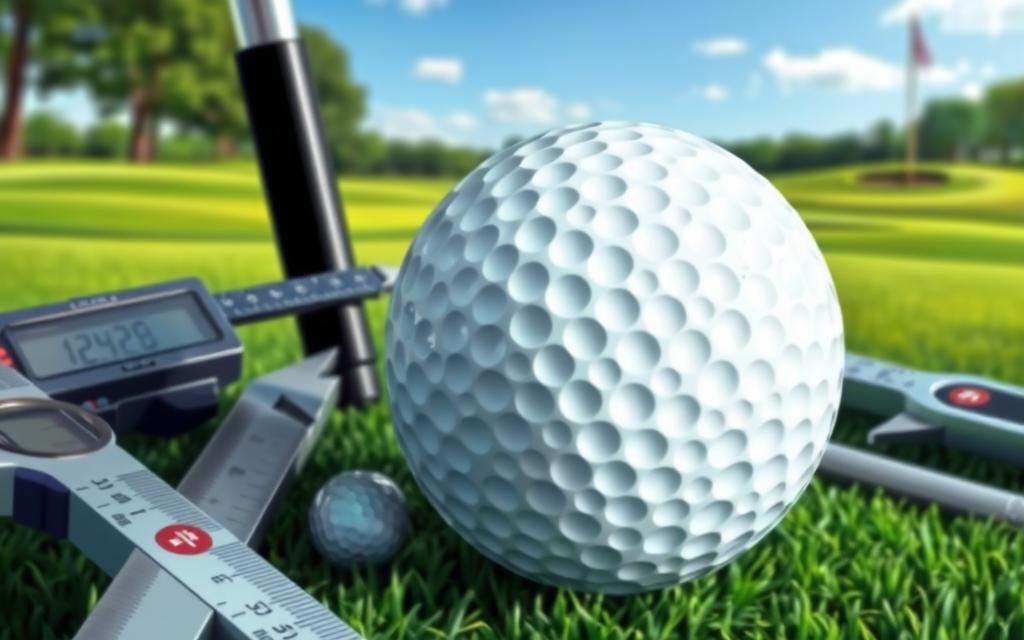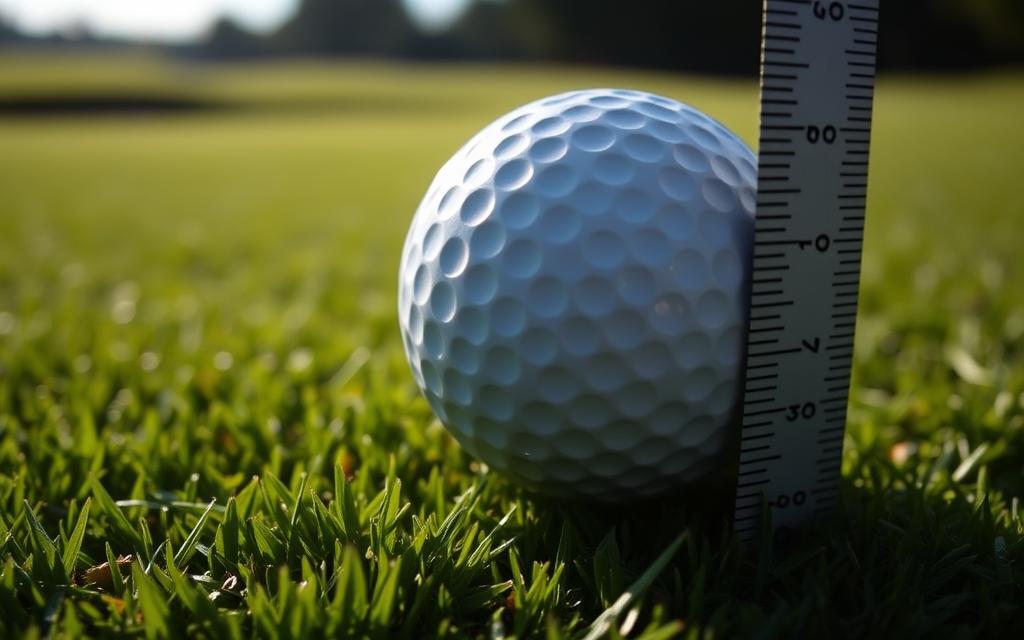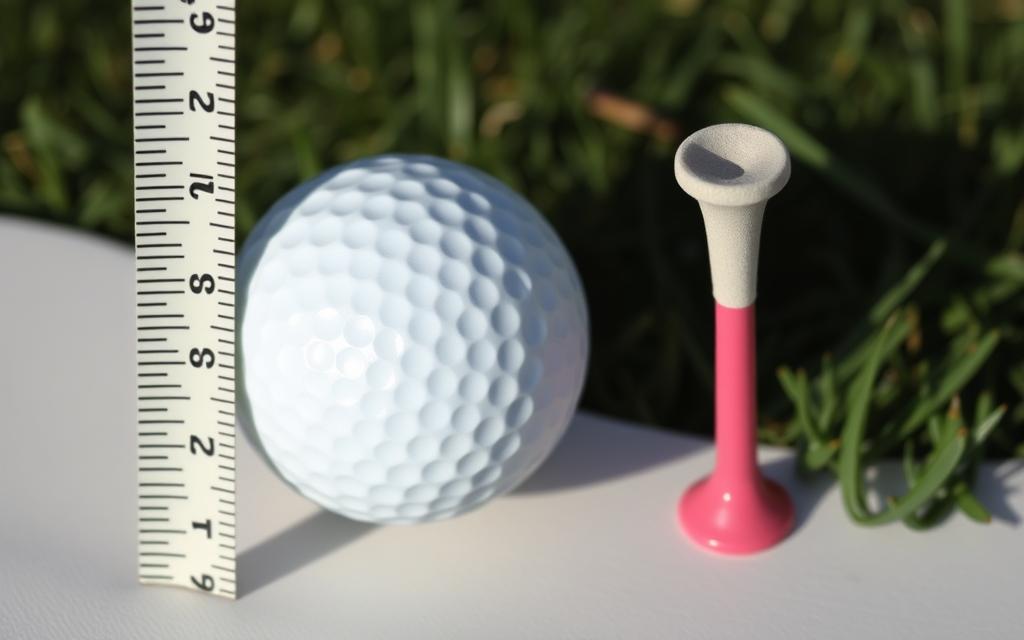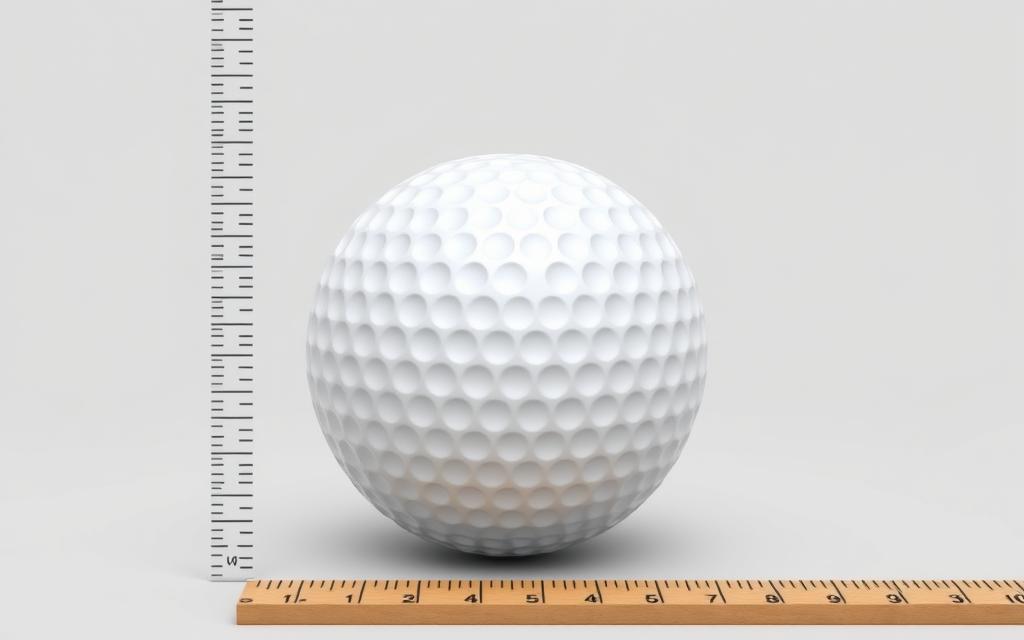Ever thought about a golf ball’s exact size? Knowing a golf ball’s radius is key to playing better. It’s not just interesting; it’s essential for your game. In this guide, we’ll explore the radius of a golf ball. We’ll look at its importance, rules, and how it shapes your golf experience.
Key Takeaways
- The standard radius of a golf ball is a critical specification that governs the game’s rules and equipment.
- Knowing the radius can help you choose the right ball for your playing style and improve your game.
- Regulations set by governing bodies ensure a level playing field and maintain the integrity of the sport.
- Radius influences key performance factors like aerodynamics, distance, and accuracy.
- Understanding the typical radius and how it compares to other sports balls can provide valuable insights.
Understanding Golf Ball Dimensions
Golf ball size is key in the game of golf. The engineering behind these balls ensures they meet strict size standards. This makes gameplay consistent across different brands and models.
Standard Size Specifications
A golf ball’s diameter is between 1.680 and 1.680 inches. This is set by the USGA and the R&A. This size ensures all golf balls used in play meet the same standards. It keeps the game fair for everyone.
Importance of Size in Performance
- The size of a golf ball affects its aerodynamics. This includes lift, drag, and spin rate. These factors influence the ball’s flight and distance.
- Smaller balls have less lift and more drag. This means they fly lower and shorter. Larger balls fly farther and higher.
- The ball’s size also affects how it feels and how well it’s controlled. It changes how the club hits the ball and how the ball responds.
Golf ball makers stick to these size standards. This ensures their balls perform well and predictably. It helps players improve and compete at the top levels.
| Golf Ball Characteristic | Standard Specification |
|---|---|
| Diameter | 1.680 – 1.680 inches (42.67 – 42.67 mm) |
| Weight | 1.620 ounces (45.93 grams) maximum |
The exact engineering and strict rules for golf ball sizes show the value of precision sports engineering in golf. Knowing these standards helps golfers choose the right ball for their game.
The Official Regulations for Golf Balls
Golf ball size matters a lot in the game. The rules for golf ball size come from the USGA and the R&A. These groups make sure golf equipment, like balls, meets certain standards.
Governing Bodies and Their Rules
The USGA and R&A say a golf ball can’t be too heavy or too small. It must weigh less than 1.62 ounces and be at least 1.68 inches in diameter. These rules have been in place for over 30 years.
Impact of Regulations on Golf Ball Design
- The rules affect how golf balls are made.
- Companies must follow these golf rules and regulations when making new balls. They aim for balls that fly far, spin well, and feel good.
- The sports equipment standards by the USGA and R&A mean all golfers play with balls that are the same. This doesn’t matter if you choose a certain brand or type.

Keeping strict golf rules and regulations for ball size helps keep the game fair. It also pushes companies to make better balls that follow the rules.
Why Radius Matters in Golf
The radius of a golf ball is very important. It affects how the ball flies and how easy it is to play. Knowing how radius impacts the ball’s flight is key for better golf.
Effects on Aerodynamics
A smaller radius makes the ball more aerodynamic. This means it flies straighter and is less affected by wind. A bigger radius makes the ball fly less smoothly, leading to less control.
Influence on Distance and Accuracy
A smaller radius helps the ball go farther. It also makes the ball fly straighter. This is because the ball moves faster and flies more smoothly.
The radius of a golf ball greatly affects its performance. By understanding how radius impacts flight, golfers can choose better equipment. This improves their game.
Typical Radius of a Golf Ball
The size of a golf ball is key in the game. Its radius is between 20.83 and 21.21 millimeters. This is about 0.82 to 0.83 inches.
Measurement in Inches and Millimeters
The rules for golf balls are clear. The max radius is 21.21 mm, and the min is 20.83 mm. This makes sure all balls are the right size for play.
Comparison with Other Sports Balls
Let’s look at how a golf ball compares to others. A tennis ball is about 32.5 mm, or 1.28 inches. A basketball is much bigger, at 121.7 mm, or 4.79 inches. This shows golf balls are quite small, which helps them fly well and play smoothly.
| Sport | Ball Radius (mm) | Ball Radius (inches) |
|---|---|---|
| Golf | 20.83 – 21.21 | 0.819 – 0.832 |
| Tennis | 32.5 | 1.28 |
| Basketball | 121.7 | 4.79 |
Knowing the radius of a golf ball is important. It helps us understand the game better. It shows how ball size affects play.
Factors That Affect Golf Ball Radius
Many things affect a golf ball’s size. Materials used and wear over time are key. These factors change the ball’s radius and how it plays on the course.
Material and Construction
The golf ball manufacturing process shapes the ball’s size and shape. The materials, like the core and cover, greatly impact the radius. High-quality balls use advanced materials for better performance.
How the ball is made also matters. Different methods, like injection molding, can change the ball’s radius. These small changes can affect how the ball flies and feels to the player.
Wear and Tear Over Time
Playing golf wears down the ball, changing its size. The number of shots, the surfaces it hits, and how hard it hits them all play a part. These factors can make the ball’s radius change over time.
- Repeated hits can damage the cover, changing the ball’s shape and size.
- Moisture and weather can also change the ball’s materials, affecting its radius.
- As a ball is used more, its radius may get smaller due to wear.
Knowing how these factors affect the ball’s radius is key. It helps players choose the right equipment for their game.
Choosing the Right Golf Ball for You
Choosing the right golf ball can really improve your game. It’s important to know about the different types of golf balls. Also, how their size affects how you play is key.
Understanding Different Ball Types
Golf balls vary in design to meet different player needs. You have the classic two-piece ball and the advanced multi-layer models. Two-piece balls are cheaper and balance distance and control well. Multi-layer balls give better spin and feel for skilled players.
How Size Affects Playability
The size of a golf ball matters a lot. Larger balls, about 1.68 inches in diameter, go farther but can be harder to control. Smaller balls are more precise and spin better, great for experienced players.
Think about your swing speed, how well you hit the ball, and the course when picking a ball. Try out different golf ball specifications and golf equipment details. Find the one that fits your style and helps you play better.

“The right golf ball can be the difference between a frustrating round and a satisfying one.”
Conclusion: Key Takeaways on Golf Ball Radius
We’ve looked at how golf ball radius is key in golf. We’ve seen how size and rules affect ball design. The size of a golf ball really matters for how well you play.
Reinforcing the Importance of Size
The size of a golf ball changes how it flies through the air. This affects how far and straight your shots go. Knowing this helps golfers pick the right ball for them.
Final Thoughts for Golf Enthuasiasts
Keep an eye on golf ball dimensions as you play. Try out different balls to find the best one for you. This will help you improve your game.
FAQ: What Is The Radius Of A Golf Ball?
What is the standard size of a golf ball?
A golf ball is 1.68 inches (42.67 mm) in diameter. This means its radius is about 0.84 inches (21.33 mm). The USGA and The R&A set this size to keep the game fair and consistent.
How can I choose the right golf ball based on its size?
Think about your skill level, playing style, and usual playing conditions when choosing a golf ball. Faster swing speeds might need a smaller radius for more distance. Slower swings might prefer a larger radius for more control. Talking to a golf pro or trying different balls can help find the right size for you.
What factors can affect the radius of a golf ball?
Many things can change a golf ball’s radius. The materials used, how it’s made, and wear and tear all play a part. The ball’s core, cover, and layers also affect its size. Use can also slightly change its radius over time.
What is the typical radius of a golf ball compared to other sports balls?
A golf ball’s radius is about 0.84 inches (21.33 mm). Tennis balls are 1.35 inches (34.29 mm), baseballs are 1.45 inches (36.83 mm), and basketballs are 2.95 inches (74.93 mm). Golf balls are smaller, which affects how they fly.
How does the radius of a golf ball impact its performance?
The radius of a golf ball greatly affects its flight and performance. A smaller radius means the ball goes faster and higher. A bigger radius makes the ball more stable and easier to control, helping with accuracy.
What are the official regulations for golf ball size?
The USGA and R&A have strict rules for golf ball size and weight. The ball must be at least 1.68 inches (42.67 mm) in diameter and weigh no more than 1.62 ounces (45.93 grams). These rules keep the game fair for everyone.
Why is the size of a golf ball important?
The size of a golf ball affects how it flies and performs. A smaller radius can make the ball go faster and higher. A bigger radius helps with stability and control. Choosing the right size ball can improve your game.



Pingback: Can a Golf ball have the same Momentum as an Elephant? A Study of Equal Momentum